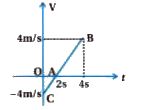The displacement of a particle is given by where x is in metre and t in second. The distance covered by the particle in first 4 seconds isSolution in Gujrati
4m
8m
12m
16m
The correct Answer is:B
Given,
Velocity,
Acceleration,
When,

u-t graphs is shown in adjacent diagram.
Distance travelled = area of the graph
= area OAC + area ABD
Topper's Solved these Questions
- MOTION IN A STRAIGHT LINE Book:KUMAR PRAKASHANChapter:MOTION IN A STRAIGHT LINE Exercise:SECTION-E
Explore 71 Videos
- MOTION IN A STRAIGHT LINE Book:KUMAR PRAKASHANChapter:MOTION IN A STRAIGHT LINE Exercise:SECTION-F
Explore 20 Videos
- MOTION IN A STRAIGHT LINE Book:KUMAR PRAKASHANChapter:MOTION IN A STRAIGHT LINE Exercise:SECTION-C
Explore 43 Videos
- MECHANICAL PROPERTIES OF FLUIDS Book:KUMAR PRAKASHANChapter:MECHANICAL PROPERTIES OF FLUIDS Exercise:QUESTION PAPER (SECTION -C)
Explore 3 Videos
- OBJECTIVE QUESTIONS AS PER NEW PAPER STYLE Book:KUMAR PRAKASHANChapter:OBJECTIVE QUESTIONS AS PER NEW PAPER STYLE Exercise:CHAPTER - 8 (Match Type questions)
Explore 5 Videos
Similar Questions
Velocity of a particle is given byv=(3t2+2t)ms. Find its average velocity between t = 0 to t=3s and also find its acceleration at t = 3s. Motion of the particle is in one dimension.
View SolutionDistance covered by ball thrown upwards with speed 'u' in last 't' seconds before it reaches max. height is .............
View SolutionWhat is acceleration ? What is the direction ? Also gives its unit.
View SolutionGlycerine flows steadily through a horizontal tube of length 1.5m and radius 1.0 cm . If the amount of glycerine collected per second at one is 4.0×10−3kgs−1 , what is the pressure difference between the two ends of the tube ? (Density of glycerine =1.3×10103kgm−3 and viscosity of glycerine =0.83 Pa s). [ you may also like to check if the assumption of laminar flow in the tube is correct]
View SolutionType of satellites are given in Column-I and their uses are given in Column-II. Match them properly :
Column-IColumn-II(1) Polar satellite(a) Tele communication(2) Geo-stationary satellite(b) Investigation(c) For information about atmosphere
View SolutionThe displacement of a particle is moving by x=(t−2)2 where x is in metres and t in second. The distance covered by the particle in first 4 seconds is.
View SolutionThe displacement of a particle is moving by x=(t−2)2 where x is in metres and t in second. The distance covered by the particle in first 4 seconds is.
View SolutionThe position of a particle is given by
x=2(t−t2)
where t is expressed in seconds and x is in metre.
The acceleration of the particle is
View SolutionThe position of a particle is given by
x=2(t−t2)
where t is expressed in seconds and x is in metre.
The particle
View SolutionThe displacement of a particle is given by x=(t-2)^(2) where x is in meters and in seconds. The distance covered by the particle in first 4 seconds is :
View SolutionDisplacement of a particle x =(t-2)^(2) Is denoted by, where x is in meters and t is in seconds, then the distance traveled by the particle in the first 4 seconds will be
View SolutionThe displacement of a particle is given by x=(t−2)2 where x is in meters and t in seconds. The distance covered by the particle in first 4 seconds is
View SolutionThe position x of a particle varies with time t as x=6+12t−2t2 where x is in metre and t is in seconds. The distance travelled by the particle in first five seconds is
View SolutionThe displacement of a particle is given by x=(t−2)2 where x is in metres and t in seconds. The distance covered by the particle in first 4 seconds is
View SolutionThe displacement of a particle is given by x=(t−2)2 where x is in metres and t in seconds. The distance covered by the particle in first 4 seconds is
View Solution
